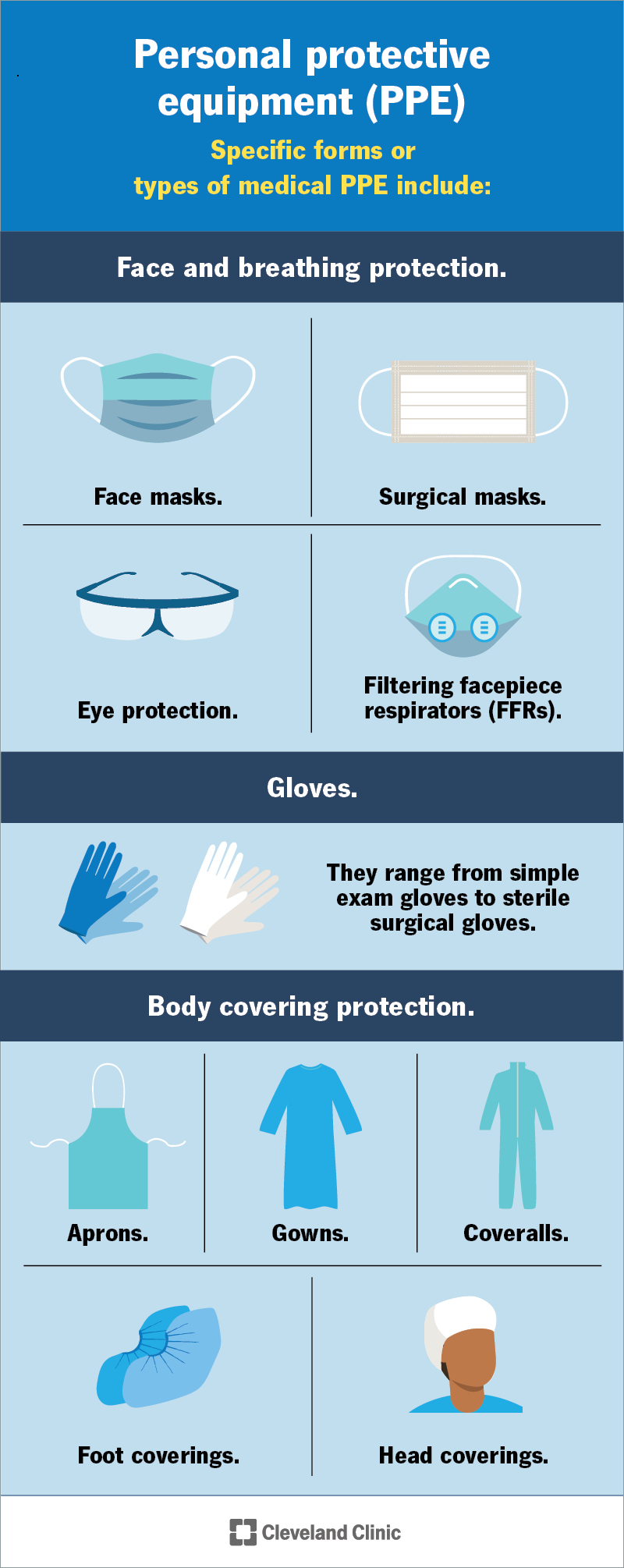Personal protective equipment, also known as PPE, can refer to all kinds of protective garments or gear. They’re a common part of healthcare, ranging from simple gloves and face masks to highly specialized wearable equipment. And outside healthcare, PPE could be important to keeping you safe and healthy, too.
Advertisement
Cleveland Clinic is a non-profit academic medical center. Advertising on our site helps support our mission. We do not endorse non-Cleveland Clinic products or services. Policy

Personal protective equipment (PPE) is a catchall term for clothes or gear that can protect you from potential harm. Healthcare relies heavily on PPE. It protects both those providing and receiving medical care alike. Understanding medical and nonmedical PPE types can help you better protect yourself and those around you.
Advertisement
Cleveland Clinic is a non-profit academic medical center. Advertising on our site helps support our mission. We do not endorse non-Cleveland Clinic products or services. Policy
When you receive medical care, it’s likely your provider will wear some type of PPE, like gloves or a mask. But PPE doesn’t just protect the wearer. It’s also there to protect you. For example, if your provider just bandaged a nasty skin infection on another person, they won’t keep wearing the same gloves. They’ll take them off, wash or sanitize their hands and then put on a fresh, clean pair before caring for you.
But PPE also includes specialized equipment, too. Many types of PPE are fitted to the wearer or require special training to use.
Specific forms or types of medical PPE include:
Face protection items include:
Advertisement
Not all medical gloves are alike. They range from simple exam gloves to sterile surgical gloves. They can also include heavier gloves for handling certain medications or chemicals.
These range from scrubs to other types of garments or equipment. But some specific types of protective coverings include:
Experts often organize types of PPE into transmission-based precautions. That means different types of PPE are necessary depending on how a condition spreads.
Gloves are standard across all levels of precautions. Face masks and surgical masks are also common, depending on the situation. The specific types of transmission-based precautions are:
Bloodborne precautions are common across a wide range of medical scenarios. Providers will use gloves for these situations, but can also use other items depending on the specifics of the case. They include:
Contact precautions are for conditions that spread person-to-person or via objects or surfaces. Gloves and disposable gowns are the standard items for contact precautions. If a provider needs to use a common tool like a stethoscope, they’ll use a single-use disposable version.
Contact precautions are for conditions like:
Providers may also wear additional protection if they could come into contact with bodily fluids.
Droplet precautions stop droplets you make when you cough, sneeze, breathe or talk. Conditions that need droplet precautions include infectious diseases like influenza or COVID-19. Droplet precaution PPE includes:
Advertisement
These are the strictest transmission-based precautions. They guard against germs that can survive for extended periods in the air or on surfaces. Airborne precautions include:
Examples of conditions that need airborne precautions include:
Outside of medical settings, using PPE can prevent serious injuries or illnesses. Some examples of nonmedical PPE include items for protecting your:
Advertisement
Some forms of PPE are very specific to certain hazards. Examples include:
Many other types of nonmedical PPE exist, depending on the specific type of work or activity involved. Local or national government agencies may be able to help you learn more, depending on your needs.
Personal protective equipment is a vital part of keeping yourself safe and healthy. While it’s an everyday fact of life for people in some industries, there are plenty of ways PPE can help everyone. If you or a loved one needs medical care that involves infection prevention precautions, don’t hesitate to ask for more information. Understanding PPE and precautions can make a big difference for everyone involved.
Advertisement
Cleveland Clinic’s primary care providers offer lifelong medical care. From sinus infections and high blood pressure to preventive screening, we’re here for you.

Last reviewed on 04/30/2025.
Learn more about the Health Library and our editorial process.